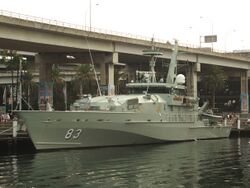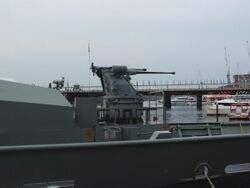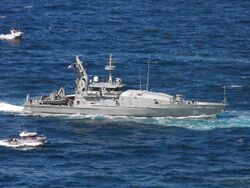Armidale-class patrol boat
Topic: Engineering
 From HandWiki - Reading time: 14 min
From HandWiki - Reading time: 14 min
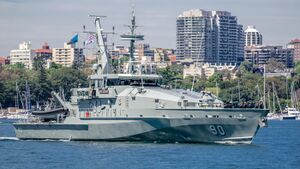 HMAS Broome
| |
| Class overview | |
|---|---|
| Name: | Armidale class |
| Builders: | Austal |
| Operators: |
|
| Preceded by: | Fremantle class |
| Succeeded by: | Arafura class and Cape class |
| Cost: | A$24–28 million per ship.[1][2] |
| Built: | 2004–2007 |
| In commission: | 2005–present |
| Completed: | 14 |
| Active: | 4 |
| Lost: | 1 |
| Retired: | 9 |
| General characteristics | |
| Type: | Patrol boat |
| Displacement: | 300 tons standard load |
| Length: | 56.8 m (186 ft) |
| Beam: | 9.7 m (32 ft) |
| Draught: | 2.7 m (8.9 ft) |
| Propulsion: | 2 × MTU 4000 16V 6,225 horsepower (4,642 kW) diesels driving twin propellers |
| Speed: | 25 knots (46 km/h; 29 mph) |
| Range: | 3,000 nautical miles (5,600 km; 3,500 mi) at 12 knots (22 km/h; 14 mph) |
| Endurance: | 21 days standard, 42 days maximum |
| Boats & landing craft carried: | 2 × Zodiac 7.2 m (24 ft) RHIBs |
| Complement: | 21 crew standard, 29 crew maximum, maximum 150 persons onboard |
| Sensors and processing systems: | Bridgemaster E surface search/navigation radar |
| Electronic warfare & decoys: |
|
| Armament: |
|
The Armidale class is a class of patrol boats built for the Royal Australian Navy (RAN). Planning for a class of vessels to replace the fifteen Fremantle-class patrol boats began in 1993 as a joint project with the Royal Malaysian Navy, but was cancelled when Malaysia pulled out of the process. The project was reopened in 1999 under the designation SEA 1444, with the RAN as the sole participant. Of the seven proposals tendered, the Austal/Defence Maritime Services (DMS) proposal for twelve vessels based on an enlarged Bay-class patrol boat was selected. Two additional boats were ordered in 2005 to provide a dedicated patrol force for the North West Shelf Venture.
All fourteen vessels were constructed by Austal at Henderson, Western Australia. The first vessel, HMAS Armidale, was commissioned into the RAN in June 2005, and the last, HMAS Glenelg, entered service in February 2008. The Armidale-class ships are operated by the Australian Patrol Boat Group, and based in Cairns and Darwin. They are primarily tasked with border protection, fisheries patrols, and the interception of unauthorised arrivals by sea. The Armidales are longer and heavier than their Fremantle-class predecessors, with improved seakeeping ability and increased range, allowing them to reach Australia's offshore territories.
During their early service life, there were problems with the fuel systems across the class, and a 20-bunk auxiliary accommodation compartment has been banned from use after toxic fumes were found in the compartment on multiple occasions. The high operational tempo from the Operation Resolute and Operation Sovereign Borders border protection and asylum seeker interception operations, combined with design flaws and poor maintenance, resulted in the ships suffering from hull fracturing around the engineering spaces, mechanical defects, and corrosion issues. DMS's contract to provide in-service support was terminated in 2017, and the patrol boats underwent a major refit in Singapore to reinforce the hull. Two Cape-class patrol boats have been chartered to supplement naval patrol boat availability during the refit cycle, and plans to replace the Armidales with an enlarged class of offshore combatant vessel have been accelerated to bring them into service by the early 2020s.
After extensive damage from an onboard fire, HMAS Bundaberg was decommissioned at the end of 2014. A fictional Armidale-class boat, HMAS Hammersley, appears in the Australian military drama series Sea Patrol from the second season onwards, with filming occurring aboard multiple ships of the class.
Development and tendering
Planning for the Armidale class began in 1993, as a plan to replace the Fremantle class, which was due for retirement in 1998.[1] This evolved into a joint program with Malaysia to construct an offshore patrol craft.[1] When Malaysia pulled out, the plan was scrapped, and the Fremantles underwent a life-extending refit.[3] The cost of maintaining the ageing vessels prompted the Department of Defence to create the Replacement Patrol Boat program, which received the procurement project designation SEA 1444.[3]
SEA 1444 marked several departures from the department's standard acquisition requirements. Instead of specifying a number of vessels, the coverage of 3,000 ship-days per year (with 1,800 to be spent on border protection operations, and a surge capability of 3,600 days) was given, with the producer to determine how many ships were needed to meet this.[3][4] The ships had to meet specific performance parameters, such as the ability to conduct boarding operations in conditions up to Sea State 4, and to maintain surveillance capability up to Sea State 5.[5] The producer was also required in the contract to provide support and maintenance for the ships, for fifteen years after construction completed.[5]
Nine companies expressed interest in the project; of these, seven had the required capability to build the ships.[4] These seven were narrowed down to three based on each tender's merit, competitiveness with the other tenders, and successful meeting of Australian industry involvement targets for both construction and long-term support.[4] Austal and Defence Maritime Services (DMS) partnered to offer twelve ships based on an expanded version of the latter's Bay-class patrol boat, in use with the Australian Customs Service.[1] The companies submitted two proposals for a 56-metre (184 ft) vessel, one with a steel hull, and one with an aluminium hull; the latter offering a 21% reduction in fuel consumption.[6] Australian Defence Industries (ADI) tendered a design based on the Royal Danish Navy's Flyvefisken-class patrol vessel.[7] The vessel was to be built with a glass-reinforced plastic hull, similar to ADI's Huon-class minehunters.[7] The Tenix proposal was a variant of a 56-metre (184 ft) search and rescue vessel constructed for the Philippine Coast Guard.[7] The tender was awarded to the Austal/DMS partnership in December 2003.[1][8] The contract was valued at $553 million, with each ship costing between $24 million and $28 million to construct.[1][2]
During the 2004 federal election, the Howard government promised to acquire two more patrol boats to provide a dedicated patrol force for the North West Shelf Venture located off the north-west coast of Australia.[5][9] These were ordered in 2005.[1] The order was placed in June 2006.[10]
Design and construction
All fourteen boats were constructed by Austal at its shipyard in Henderson, Western Australia.[11] Lead ship HMAS Armidale was commissioned into the RAN in June 2005.[11] Two other patrol boats were delivered to the RAN in 2005, six in 2006, and five in 2007, with the final ship in the class, HMAS Glenelg, delivered in October 2007 and commissioned in February 2008.[1] At one stage, six vessels were being constructed simultaneously.[1]
Each patrol boat has a length of 56.8 metres (186 ft), a beam of 9.7 metres (32 ft), a draught of 2.7 metres (8.9 ft), and a standard displacement of 300 tons.[11] The hull is of the semi-displacement vee type, and is fabricated from aluminum alloy.[1] The ship is designed to a combination of Det Norske Veritas standards for high-speed light craft and RAN requirements: much effort went into avoiding attempts to overengineer the Armidales or turn them into 'miniature warships'.[1]
The Armidales can travel at a maximum speed of 25 knots (46 km/h; 29 mph), and are driven by two propeller shafts, each connected to an MTU 4000 16V diesel engine, providing 6,225 horsepower (4,642 kW).[11] The ships have a range of 3,000 nautical miles (5,600 km; 3,500 mi) at 12 knots (22 km/h; 14 mph), allowing them to patrol the waters around the distant territories of Australia, including the Cocos (Keeling) Islands and Christmas Island.[1] The Armidale class has demonstrated an improved seakeeping ability over the preceding Fremantle class: the Armidales are 15 metres (49 ft) longer, 85 tons heavier, and have hydraulic stabiliser fins and trim tabs incorporated into the design, allowing them to survive conditions up to Sea State 9.[1] The vessels are designed for standard patrols of 21 days, with a maximum endurance of 42 days.[1][9]
Weapons and systems
The main armament of the Armidale class is a Rafael Typhoon stabilised 25-millimetre (0.98 in) gun mount fitted with an M242 Bushmaster autocannon.[9] This cannon has a rate of fire of 200 rounds per minute, and is controlled remotely from the bridge.[12] Two 12.7-millimetre (0.50 in) machine guns are also carried.[12]
Boarding operations are performed by two 7.2-metre (24 ft), waterjet propelled rigid-hulled inflatable boats (RHIB), which carry ten people (a fully equipped, eight-strong boarding party, and two boat crew).[1] The RHIBs are larger and more powerful than the single RHIB aboard a Fremantle, are capable of operating independently of their mothership, and carry their own communications, navigation, and safety equipment.[1][13] Each RHIB has a dedicated cradle and davit, the boats can be launched and recovered easily, and a centralised 'dressing room' incorporated into the ship's design has streamlined the deployment and return of personnel.[1]
The patrol boats are fitted with a Bridgemaster E surface search and navigational radar, a Toplite electro-optical detection system, and a Warrlock direction finding system.[1][11][13] A Prism III radar warning system was fitted to the last two boats during construction, and retro-fitted to the rest.[1] Tenders for a Naval Unmanned Aerial System (NUAS) capability for the Armidale class were requested in mid-2014.[14]
Complement
Each patrol boat has a standard ship's company of 21 personnel, with a maximum of 29 (not including use of the austere compartment).[1][9] Unlike the Fremantle-class patrol boats, the Armidales do not have a permanently assigned ship's company.[1] Instead, there are 21 crews established for the 14 Armidale-class patrol boats, which are divided up into four divisions: Attack, Assail, Ardent, and Aware.[2] The first three of the Divisions are assigned six crews for four ships, while Aware has three crews for two ships.[1] The ships are continually manned, with two out of three crews actively deployed while the third undergoes leave or training, or prepares to transfer into a ship: a handover can be accomplished in less than six hours.[1] The intention of multi-crewing is to allow the ships to spend more time at sea, without compromising sailors' rest time or training requirements.[2]
Junior sailors are housed in four-berth cabins, as opposed to the central sixteen-berth mess deck of the Fremantles, while senior sailors and commissioned officers either have individual or share two-berth cabins.[1] Personnel have access to e-mail and satellite television, and the galley is better equipped than that on a Fremantle-class vessel and better suited to use in heavy seas.[1] The comfort of personnel is also significantly improved over the Fremantles, with air conditioning throughout the entire ship (excluding engine and machinery compartments).[1]
Problems
The introduction of the class into service has not been without problems. Since June 2005, all active Armidales have undergone operating restrictions on two occasions, both due to water contamination of the main fuel systems.[2] The first occurrence, in September 2006, led to the suspension of operations by the patrol boats for a month, and the engineering controls were redesigned.[1] The problem occurred again in January 2007, and led to an 'operational pause' while Austal redesigned the fuel system, engineering procedures were altered, and fuel quality criteria were tightened.[1] The five ships yet to be completed were fitted with the modified fuel system during construction, while the active ships were refitted over the course of 2007.[1] As of December 2007, no further fuel problems have occurred.[1]
A 20-berth auxiliary accommodation compartment (the 'austere' compartment) was included in the design, for the transportation of soldiers, illegal fishermen, or unauthorised arrivals; in the latter two cases, the compartment could be secured from the outside.[15] However, a malfunction in the sewage treatment facilities aboard HMAS Maitland in August 2006 pumped hydrogen sulphide and carbon monoxide into the compartment, non-fatally poisoning four sailors working inside[2][15] resulting in use of the compartment as accommodation being heavily restricted across the class.[2][16] In 2010, allegations were made to The Australian that a sailor working in the austere compartment on a different vessel had been gassed with hydrogen sulphide, and carbon monoxide was regularly detected in the enclosed space.[15] Following publication of the allegations, Chief of Navy Russ Crane claimed that there was no record of the alleged gassing incident, and while there were ongoing incidents of poisonous gasses detected in the compartment, the sensors were set to trigger well below dangerous levels, and modifications were being made to the sewerage and ventilation systems.[17]
In 2014, the navy reported the recurrence of hull cracking around the engine spaces, which has been attributed to a combination of design issues related to the aluminium hull, and the high tempo of operations.[18] By 2015, several patrol boats were confined to port because of structural, mechanical, and corrosion issues.[18] In response, the Department of Defence threatened to cancel DMS' maintenance contract based on the company's poor performance in maintaining the Armidale's (but did not go ahead due to the political repercussions from potentially losing local jobs).[18] Defence and Serco (the parent company of DMS) later agreed to end the contract in 2017, with the Australian government to tender for a new in-service support contract during 2016.[19] The patrol boat fleet began a mid-life refit program in October 2015, in order to extend hull life until a replacement class of larger vessels enters service from 2022.[19] The patrol boats were refitted two at a time in Singapore, with the RAN chartering the Cape-class patrol boats Cape Byron and Cape Nelson from mid-2015 until the end of 2016 to supplement naval patrol boat availability.[18][19] During work on the first two patrol boats, the estimated cost of work-per-vessel doubled to A$7 million.[19]
Operational history
The Armidale-class ships are operated by the Australian Patrol Boat Group and are primarily tasked with border protection and fisheries patrols.[2] Multiple Armidale-class boats are assigned to patrols of Australian waters at any given time as part of Operation Resolute (and later Operation Sovereign Borders[citation needed]), with an ability to surge further vessels when required.[20]
On introduction of the Armidale class, the Australian Patrol Boat Group was reorganised into four divisions, named after Attack class ships:
- 1st/Attack Division (HMAS Coonawarra, Darwin)
- Six Armidale Class patrol boat crews (Attack 1–6)
- 2nd/Assail Division (HMAS Coonawarra)
- Six Armidale Class patrol boat crews (Assail 1–6)
- 3rd/Ardent Division (HMAS Cairns, Cairns)
- Six Armidale Class patrol boat crews (Ardent 1–6)
- 4th/Aware Division (Dampier, Western Australia)
- Three Armidale Class patrol boat crews (Aware 1–3) (based in Darwin)
The Patrol Boat force has subsequently been reorganised to allocate a single crew to each platform.
At the start of 2014, the long transit differences and near-constant deployment of the patrol boats for Operation Resolute was impacting on the ability to keep the vessels properly maintained.[16]
In August 2014, a fire broke out aboard Bundaberg while undergoing refit work at a civilian shipyard in Hemmant, Queensland.[21][22] The patrol boat was damaged beyond repair and was decommissioned on 18 December.[23]
In November 2017 the RAN began deploying Armidale-class patrol boats to the Philippines. The boats have been used to conduct counter-terrorism patrols in the Sulu Sea with the Philippine Navy.[24]
Fleet list
| Ship | Pennant | Homeport | Commissioning date[11] | Commissioning location | Decommissioned |
|---|---|---|---|---|---|
| Armidale | P83 | HMAS Coonawarra, Darwin | 24 June 2005 | Darwin | 30 March 2023[25] |
| Larrakia | P84 | HMAS Coonawarra, Darwin | 10 February 2006 | Darwin | 28 September 2023[26] |
| Bathurst | P85 | HMAS Coonawarra, Darwin | 10 February 2006 | Darwin | N/A |
| Albany | P86 | HMAS Coonawarra, Darwin | 15 July 2006 | Albany | N/A |
| Pirie | P87 | HMAS Coonawarra, Darwin | 29 July 2006 | Port Pirie | 26 March 2021[27] |
| Maitland | P88 | HMAS Coonawarra, Darwin | 29 September 2006 | Newcastle | 28 April 2022 |
| Ararat | P89 | HMAS Coonawarra, Darwin | 10 November 2006 | Melbourne | 2 July 2022[28] |
| Broome | P90 | HMAS Coonawarra, Darwin | 10 February 2007 | Broome | N/A |
| Bundaberg | P91 | HMAS Cairns, Cairns | 3 March 2007 | Bundaberg | 18 December 2014 |
| Wollongong | P92 | HMAS Cairns, Cairns | 23 June 2007 | Sydney | 8 December 2022 |
| Childers | P93 | HMAS Coonawarra, Darwin | 7 July 2007 | Cairns | N/A |
| Launceston | P94 | HMAS Coonawarra, Darwin | 22 September 2007 | Launceston | 1 June 2023[29] |
| Maryborough | P95 | HMAS Coonawarra, Darwin | 8 December 2007 | Brisbane | 28 September 2023[30] |
| Glenelg | P96 | HMAS Coonawarra, Darwin | 22 February 2008 | Adelaide | 7 October 2022 |
Appearances in fiction
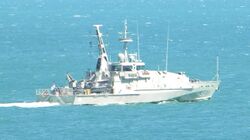
From the second season onwards of Sea Patrol, an Australian military drama series, the fictional Armidale-class patrol boat HMAS Hammersley (pennant number 82) is used as the main setting.[31] In 2008, two ships were conflated to represent Hammersley: 42 of the 86 days of filming were spent aboard HMAS Broome, with later pick-up filming aboard HMAS Launceston.[31]
Replacement
Defending Australia in the Asia Pacific Century: Force 2030, the 2009 Department of Defence white paper, proposed replacing the Armidales, along with the RAN's mine warfare and hydrographic vessels, with a single class of multi-role offshore combatant vessels (OCVs).[32][33] These vessels, with a theoretical maximum displacement up to 2,000 tonnes, would use a modular mission payload system to change between roles as required, and would be equipped for helicopter or unmanned aerial vehicle operations.[32][33][34][35] The 2013 white paper postponed the multi-role OCV as a long-term project.[36]
The 2013 white paper proposed that an existing OCV design be sourced as a short-term replacement for the Armidale class.[36] Procurement project SEA 1179 is undertaking several studies towards the replacement of the Armidales.[37] In April 2016, the Lürssen OPV80A design was selected to replace the Armidale class ships. The replacement OPVs will be larger and provide improved seakeeping and endurance.[38] Construction started in 2018, with entry into service planned from 2022.[38][39] A hull remediation program was implemented to extend the lifespans of the patrol boats to this point.[18] In 2020, the RAN decided to acquire six evolved Cape class patrol boats instead of performing a full life of type extension (LOTE) on six Armidale class boats.[40][41]
Citations
- ↑ 1.00 1.01 1.02 1.03 1.04 1.05 1.06 1.07 1.08 1.09 1.10 1.11 1.12 1.13 1.14 1.15 1.16 1.17 1.18 1.19 1.20 1.21 1.22 1.23 1.24 1.25 1.26 1.27 1.28 1.29 Kerr, Plain sailing
- ↑ 2.0 2.1 2.2 2.3 2.4 2.5 2.6 2.7 Kerr, Patrol boats shake down fuel faults
- ↑ 3.0 3.1 3.2 Heron & Powell, in Australian Maritime Issues 2006, p. 129
- ↑ 4.0 4.1 4.2 Finalists await Patrol Boat decision, in Defence Today, p. 36
- ↑ 5.0 5.1 5.2 Heron & Powell, in Australian Maritime Issues 2006, p. 130
- ↑ Finalists await Patrol Boat decision, in Defence Today, p. 38
- ↑ 7.0 7.1 7.2 Finalists await Patrol Boat decision, in Defence Today, p. 40
- ↑ Ships Announced as Prefered Tenderer for Royal Australian Navy Patrol Boats Austral 29 August 2003
- ↑ 9.0 9.1 9.2 9.3 Wertheim (ed.), The Naval Institute Guide to Combat Fleets of the World, p. 22
- ↑ Austal Receives Order for an Additional Two Royal Australian Navy Patrol Boats Austal 30 June 2006
- ↑ 11.0 11.1 11.2 11.3 11.4 11.5 Saunders (ed.), IHS Jane's Fighting Ships 2012–2013, p. 33
- ↑ 12.0 12.1 Heron & Powell, in Australian Maritime Issues 2006, p. 132
- ↑ 13.0 13.1 Heron & Powell, in Australian Maritime Issues 2006, p. 131
- ↑ Australian Aviation, DMO releases UAS tender
- ↑ 15.0 15.1 15.2 McKenna, Gas risk remains for navy boats
- ↑ 16.0 16.1 McPhedran, The navy's patrol boat fleet is over worked and under maintained according to a new report
- ↑ Crane, Gas Risk Remains for Navy Boats – A Response from the Chief of the Navy
- ↑ 18.0 18.1 18.2 18.3 18.4 McPhedran, The $3 million cost of Navy’s decision to lease patrol boats for border protection
- ↑ 19.0 19.1 19.2 19.3 Stewart, Navy patrol boat repairs blow out by $45m
- ↑ Australian Department of Defence, Operation RESOLUTE
- ↑ Department of Defence, Defence update on HMAS Bundaberg fire (press release)
- ↑ Radulova, Fire! Navy patrol boat HMAS Bundaberg engulfed in flames during maintenance work in a Brisbane dry dock
- ↑ Staples, HMAS Bundaberg decommissioned
- ↑ Graham, Euan. "Australian warships challenged in South China Sea". Lowy Institute. https://www.lowyinstitute.org/the-interpreter/australian-navy-challenged-south-china-sea.
- ↑ "Farewell to the first of its class". Department of Defence. 4 April 2023. https://www.defence.gov.au/news-events/news/2023-04-04/farewell-first-its-class.
- ↑ "Decommissioning of HMAS Maryborough and HMAS Larrakia". https://www.navy.gov.au/event/decommissioning-hmas-maryborough-and-hmas-larrakia.
- ↑ "HMAS Pirie (II)". https://www.navy.gov.au/hmas-pirie-ii.
- ↑ "HMAS Ararat decommissions in Darwin". Department of Defence. 2 July 2022. https://news.defence.gov.au/media/media-releases/hmas-ararat-decommissions-darwin.
- ↑ Leslie, André (2023-05-25). "After a long and storied history, the name HMAS Launceston is set to disappear from the navy — for now, at least" (in en-AU). ABC News. https://www.abc.net.au/news/2023-05-26/naval-ship-hmas-launceston-decommissioned/102386188.
- ↑ "Decommissioning of HMAS Maryborough and HMAS Larrakia". https://www.navy.gov.au/event/decommissioning-hmas-maryborough-and-hmas-larrakia.
- ↑ 31.0 31.1 Idato, All ship shape
- ↑ 32.0 32.1 Department of Defence, Defending Australia in the Asia Pacific Century
- ↑ 33.0 33.1 Sea Power Centre, Australian Offshore Combatant Vessels
- ↑ Thornton, The Rationale for the RAN Offshore Combatant Vessel
- ↑ Boettger, The Offshore Combatant Vessel
- ↑ 36.0 36.1 Department of Defence, Defence White Paper 2013
- ↑ Defence Science and Technology Organisation, Patrol boat replacement
- ↑ 38.0 38.1 Mead, On track to deliver even more
- ↑ "Construction of 3rd Arafura-class OPV begins for Australian Navy – Naval Post". 8 April 2020. https://navalnews.net/construction-of-3rd-arafura-class-opv-begins-for-australian-navy/.
- ↑ Minister for Defence Linda Reynolds; Minister for Defence Industry Melissa Price (1 May 2020). "New patrol boats to boost Navy capability". Department of Defence Ministers (Press release). Retrieved 17 September 2022.
- ↑ Australian National Audit Office (2021). Department of Defence’s Procurement of Six Evolved Cape Class Patrol Boats. ANAO Report No.15 2021–22. Canberra: The Auditor-General. pp. 14-15. ISBN 9781760337001. https://www.anao.gov.au/sites/default/files/Auditor-General_Report_2021-22_15.pdf. Retrieved 20 March 2023.
References
Books
- Department of Defence (2 May 2009). Defending Australia in the Asia Pacific Century: Force 2030. Commonwealth of Australia. pp. 72–3. ISBN 978-0-642-29702-0. OCLC 426475923.
- Department of Defence (3 May 2013). Defence White Paper 2013. Commonwealth of Australia. p. 84. ISBN 978-0-9874958-0-8.
- Heron, Wesley; Powell, Anthony (2007). "Welcome to the Armidale Class". in Forbes, Andrew. Australian Maritime Issues 2006. Papers in Australian Maritime Affairs. Sea Power Centre – Australia. pp. 129–134. ISBN 978-0-642-29644-3. http://www.navy.gov.au/w/images/PIAMA19.pdf. Retrieved 12 May 2010.
- Saunders, Stephen, ed (2012). IHS Jane's Fighting Ships 2012–2013. Jane's Fighting Ships. Coulsdon: IHS Jane's. ISBN 9780710630087. OCLC 793688752.
- Wertheim, Eric, ed (2007). The Naval Institute Guide to Combat Fleets of the World: Their Ships, Aircraft, and Systems (15th ed.). Annapolis, MD: Naval Institute Press. ISBN 978-1-59114-955-2. OCLC 140283156. https://books.google.com/books?id=TJunjRvplU4C.
Journal and news articles
- Boettger, Daniel (December 2009). "The Offshore Combatant Vessel: Future Flexibility". Headmark (Australian Naval Institute) (134): 31. ISSN 1833-6531.
- "DMO releases UAS tender". Australian Aviation. 30 May 2014. http://australianaviation.com.au/2014/05/dmo-releases-uas-tender/.
- "Finalist await Patrol Boat decision". Defence Today 2 (1): 36–40. February 2003. ISSN 1447-0446.
- Idato, Michael (31 March 2008). "All ship shape". SydneyMorningHerald.com.au, Entertainment (TV and Radio) section: p. 2. http://www.smh.com.au/news/tv--radio/all-ship-shape/2008/03/29/1206207482199.html?page=2.
- Kerr, Julian (1 January 2008). "Plain sailing: Australia's Armidales prove fit for task". Jane's Navy International (Jane's Information Group).
- Kerr, Julian (8 December 2007). "Patrol boats shake down fuel faults". The Australian: Defence Special Report: p. 8.
- McKenna, Michael (2 January 2010). "Gas risk remains for navy boats". The Australian. http://www.theaustralian.com.au/news/nation/gas-risk-remains-for-navy-boats/story-e6frg6nf-1225815368349.
- McPhedran, Ian (4 January 2014). "The navy's patrol boat fleet is over worked and under maintained according to a new report". Herald Sun. http://www.heraldsun.com.au/news/national/the-navys-patrol-boat-fleet-is-over-worked-and-under-maintained-according-to-a-new-report/story-fni0xqrb-1226794610065.
- McPhedran, Ian (9 October 2015). "The $3 million cost of Navy's decision to lease patrol boats for border protection". News.com.au. http://www.news.com.au/national/the-3-million-cost-of-navys-decision-to-lease-patrol-boats-for-border-protection/story-fncynjr2-1227563727636.
- Mead, Jonathan (10 September 2015). "On track to deliver even more". Navy News. http://navynews.realviewdigital.com/?iid=127437#folio=2.
- "Australian Offshore Combatant Vessels". Semaphore (Sea Power Centre – Australia) 2010 (4). May 2010. http://www.navy.gov.au/w/images/Semaphore_2010_4.pdf. Retrieved 13 August 2010.
- Staples, Natalie (19 December 2014). "HMAS Bundaberg decommissioned". Navy Daily (Royal Australian Navy). http://news.navy.gov.au/en/Dec2014/Fleet/1682.
- Stewart, Cameron (6 January 2016). "Navy patrol boat repairs blow out by $45m". The Australian. http://www.theaustralian.com.au/national-affairs/defence/navy-patrol-boat-repairs-blow-out-by-45m/news-story/4d46bf79263096118475982d1f873b8d.
- Thornton, Sean (January 2010). "The Rationale for the RAN Offshore Combatant Vessel". The Navy (Navy League of Australia) 72 (1): 6–10. ISSN 1322-6231.
Press releases
- "Defence update on HMAS Bundaberg fire" (Press release). Canberra, ACT: Department of Defence. 12 August 2014. Archived from the original on 12 August 2014. Retrieved 12 August 2014.
Websites
- "Operation RESOLUTE". Global Operations. Australian Department of Defence. http://www.defence.gov.au/opEx/global/opresolute/index.htm.
- "Patrol boat replacement". Defence Science and Technology Organisation. 25 June 2014. http://www.dsto.defence.gov.au/projects/patrol-boat-replacement.
- Crane, Russ (2 January 2010). "Gas Risk Remains for Navy Boats – A Response from the Chief of the Navy". Navy League of Australia. http://navyleague.org.au/gas-risk-remains-for-navy-boats-a-response-from-the-chief-of-the-navy/.
External links
- Patrol Boat (PB) – Royal Australian Navy webpage for the Armidale class
- Delivery Royal Australian Navy 56m – Austal Ships webpage for the Armidale class
- The Armidale Class Patrol Boat Project: Project Management – Australian National Audit Office report on the acquisition of the class
- New patrol boats named after regional cities – Department of Defence press release detailing the meaning behind the names of the first 12 Armidales
 |
 KSF
KSF